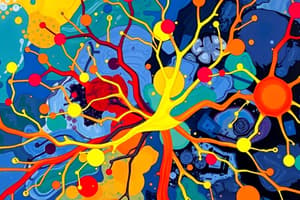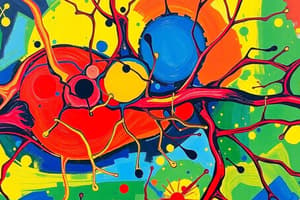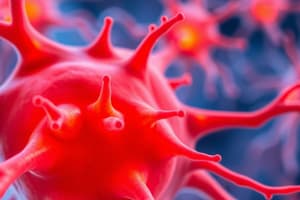Podcast
Questions and Answers
Which of the following correctly describes matter?
Which of the following correctly describes matter?
- Matter is any substance that occupies space and has mass. (correct)
- Matter does not have any measurable physical properties.
- Matter can only be composed of organic substances.
- Matter is a substance that exists only as a solid.
What is a pure substance?
What is a pure substance?
- A compound that contains multiple types of atoms.
- A substance that cannot be broken down by chemical means. (correct)
- A mixture of two or more elements.
- Any substance that has a boiling point.
Which of the following statements about compounds is true?
Which of the following statements about compounds is true?
- Compounds can exist independently of their constituent elements.
- Compounds consist of only one element.
- Compounds contain two or more elements in definite proportions. (correct)
- Compounds are always visible to the human eye.
Which particle in an atom has a positive charge?
Which particle in an atom has a positive charge?
How do isotopes of an element differ from each other?
How do isotopes of an element differ from each other?
What is the atomic number of an element?
What is the atomic number of an element?
Which statement about electrons is accurate?
Which statement about electrons is accurate?
What does the Bohr model illustrate?
What does the Bohr model illustrate?
What is the main reason atoms interact to form molecules?
What is the main reason atoms interact to form molecules?
Which of the following describes the number of electrons in the second shell of an atom?
Which of the following describes the number of electrons in the second shell of an atom?
What type of charge is associated with cations?
What type of charge is associated with cations?
How many additional electrons does oxygen need to fill its outer shell?
How many additional electrons does oxygen need to fill its outer shell?
Which group of elements would typically have one fewer electron than needed to fill their valence shell?
Which group of elements would typically have one fewer electron than needed to fill their valence shell?
What is the primary function of dendrites in a neuron?
What is the primary function of dendrites in a neuron?
Which type of glial cell primarily produces cerebrospinal fluid (CSF)?
Which type of glial cell primarily produces cerebrospinal fluid (CSF)?
What is the primary role of oligodendrocytes in the central nervous system?
What is the primary role of oligodendrocytes in the central nervous system?
What is the typical resting membrane potential of a neuron?
What is the typical resting membrane potential of a neuron?
What is long-term potentiation (LTP)?
What is long-term potentiation (LTP)?
Which neurotransmitter is primarily involved in muscle contraction?
Which neurotransmitter is primarily involved in muscle contraction?
Which of the following correctly describes long term potentiation?
Which of the following correctly describes long term potentiation?
What distinguishes glial cells from neurons in the nervous system?
What distinguishes glial cells from neurons in the nervous system?
What is the function of ependymal cells in the central nervous system?
What is the function of ependymal cells in the central nervous system?
What is the threshold potential that a neuron must reach for an action potential to occur?
What is the threshold potential that a neuron must reach for an action potential to occur?
What is the role of the presynaptic neuron in synaptic transmission?
What is the role of the presynaptic neuron in synaptic transmission?
Which type of synaptic potential is characterized by a decrease in the likelihood of a postsynaptic neuron firing?
Which type of synaptic potential is characterized by a decrease in the likelihood of a postsynaptic neuron firing?
What is glioblastoma associated with?
What is glioblastoma associated with?
What is the role of ligand-gated receptors on the postsynaptic neuron?
What is the role of ligand-gated receptors on the postsynaptic neuron?
What is the basic structural and functional unit of the nervous system?
What is the basic structural and functional unit of the nervous system?
Which cells in the peripheral nervous system are similar in function to oligodendrocytes in the central nervous system?
Which cells in the peripheral nervous system are similar in function to oligodendrocytes in the central nervous system?
What is the primary purpose of cellular respiration?
What is the primary purpose of cellular respiration?
What is the function of glucagon in glucose homeostasis?
What is the function of glucagon in glucose homeostasis?
Which of the following describes a characteristic of electrical synapses?
Which of the following describes a characteristic of electrical synapses?
What is one effect of long-term potentiation in synaptic plasticity?
What is one effect of long-term potentiation in synaptic plasticity?
How do chemical synapses differ from electrical synapses?
How do chemical synapses differ from electrical synapses?
What role does ATP play in active transport?
What role does ATP play in active transport?
Which layer of biological organization is represented by a group of organisms of the same species in a certain area?
Which layer of biological organization is represented by a group of organisms of the same species in a certain area?
What is synaptic plasticity and why is it important for learning?
What is synaptic plasticity and why is it important for learning?
What characterizes the valence shell in an atom?
What characterizes the valence shell in an atom?
Which statement about the Bohr model is true?
Which statement about the Bohr model is true?
Which electron configuration corresponds to a stable noble gas?
Which electron configuration corresponds to a stable noble gas?
What is the maximum number of electrons that can occupy an s orbital?
What is the maximum number of electrons that can occupy an s orbital?
In terms of potential energy, which statement is correct during an electron transition?
In terms of potential energy, which statement is correct during an electron transition?
Which of the following correctly describes the octet rule?
Which of the following correctly describes the octet rule?
What is unique about electrons in the valence shell?
What is unique about electrons in the valence shell?
Which of the following elements has an atomic number of 3?
Which of the following elements has an atomic number of 3?
Flashcards
Synapse
Synapse
The junction between two neurons where signals are transmitted.
Neuron
Neuron
The basic functional unit of the nervous system that conducts and integrates information.
Neurotransmitters
Neurotransmitters
Chemical messengers that transmits signals across synapses.
Synaptic cleft
Synaptic cleft
Signup and view all the flashcards
Long-term potentiation (LTP)
Long-term potentiation (LTP)
Signup and view all the flashcards
Glial cells
Glial cells
Signup and view all the flashcards
Astrocytes
Astrocytes
Signup and view all the flashcards
Glioblastoma
Glioblastoma
Signup and view all the flashcards
Action Potential
Action Potential
Signup and view all the flashcards
Resting Potential
Resting Potential
Signup and view all the flashcards
Threshold Potential
Threshold Potential
Signup and view all the flashcards
Chemical Synapse
Chemical Synapse
Signup and view all the flashcards
Neurotransmitters
Neurotransmitters
Signup and view all the flashcards
EPSP/IPSP
EPSP/IPSP
Signup and view all the flashcards
Glia cells
Glia cells
Signup and view all the flashcards
Scientific Method
Scientific Method
Signup and view all the flashcards
Chemical synapse operation
Chemical synapse operation
Signup and view all the flashcards
ESPS
ESPS
Signup and view all the flashcards
ISPS
ISPS
Signup and view all the flashcards
Synaptic plasticity
Synaptic plasticity
Signup and view all the flashcards
Long-term potentiation (LTP)
Long-term potentiation (LTP)
Signup and view all the flashcards
ATP
ATP
Signup and view all the flashcards
Cellular respiration
Cellular respiration
Signup and view all the flashcards
Facilitated diffusion
Facilitated diffusion
Signup and view all the flashcards
Pure Substance
Pure Substance
Signup and view all the flashcards
Compound
Compound
Signup and view all the flashcards
Molecule
Molecule
Signup and view all the flashcards
Atom
Atom
Signup and view all the flashcards
Atomic Number
Atomic Number
Signup and view all the flashcards
Atomic Mass
Atomic Mass
Signup and view all the flashcards
Isotope
Isotope
Signup and view all the flashcards
Matter
Matter
Signup and view all the flashcards
Electron Shell
Electron Shell
Signup and view all the flashcards
Valence Electrons
Valence Electrons
Signup and view all the flashcards
Octet Rule
Octet Rule
Signup and view all the flashcards
Electron Configuration
Electron Configuration
Signup and view all the flashcards
Atomic Number
Atomic Number
Signup and view all the flashcards
Bohr Model
Bohr Model
Signup and view all the flashcards
Orbital
Orbital
Signup and view all the flashcards
Period (Periodic Table)
Period (Periodic Table)
Signup and view all the flashcards
Group (Periodic Table)
Group (Periodic Table)
Signup and view all the flashcards
Valence Electrons
Valence Electrons
Signup and view all the flashcards
Lewis Structure
Lewis Structure
Signup and view all the flashcards
Atom Interactions
Atom Interactions
Signup and view all the flashcards
Cation
Cation
Signup and view all the flashcards
Group 1 Elements
Group 1 Elements
Signup and view all the flashcards
Study Notes
Synapses
- Synapses are junctions between two neurons, meaning "together"
- Neurons are the basic functional units of the nervous system, conducting messages and integrating information.
- Neurons come in various shapes and sizes (figures 35.4 and 35.5)
- Neurons share basic characteristics.
- A neuron (anatomy) consists of a soma (cell body), an axon (long, transmitting away from the cell body), and dendrites (short, branched, receiving information).
- Axons of many neurons form nerves.
- Synapses are junctions between neurons (APP fig 12.27)
- Part of the presynaptic neuron
- Neurotransmitters
- Postsynaptic neuron
Chemical Synapses
- A sequence of activity (fig 9.3)
- The presynaptic neuron synthesizes neurotransmitters (NT).
- Examples of neurotransmitters: acetylcholine (NS, muscles), dopamine (brain, mood), endorphins (pain regulation)
- Neurotransmitters diffuse across the synaptic cleft (20 mm wide)
- The postsynaptic neuron's plasma membrane receptors bind to the neurotransmitters.
- This binding triggers an electrical impulse.
- Activity at synapses underlies memory and learning.
- The brain can be remodeled as a result of neuronal plasticity.
- This occurs mostly at synapses in response to activity.
- Long-term potentiation (LTP) leads to long-lasting increases in synaptic strength.
Glial Cells
- Glial cells are non-neuronal cells in the nervous system.
- They do not produce electrical impulses.
- There are more glial cells than neurons.
- Glial cells show more diversity and function than neurons.
- Types of glial cells include ependymal cells (produce CSF), astrocytes (regulate CSF composition), microglia (fight infection), and oligodendrocytes (electrical insulation).
- Glioblastoma is the most common and aggressive type of brain tumor, originating from astrocytes.
Learning and Memory
- Learning is a process of behavioral change from experience, reducing the probability of nonproductive outcomes.
- Memory involves physiological and anatomical changes in the nervous system.
- The nervous system involves neurons and glia.
- The central nervous system (CNS) and peripheral nervous system (PNS) are involved in the process of learning and memory.
- Glial cells and neurons are essential to the process of learning and memory.
- In nervous tissue, there are neurons and glia.
- In CNS, glial cells include: astrocytes, microglia, oligodendrocytes
- In PNS: glial cells include satellite cells and Schwann cells
Test Review
- Membrane potential is a measure of electrical potential in a cell.
- Voltage channels are made of proteins.
- Resting potential (70mV) represents a stable membrane potential state.
- A threshold potential (55mV) activates the start of a new action potential.
- An action potential (the change in membrane potential from -55mV → 35mV → -70mV) activates transport.
- Neurotransmitters can activate EPSPs (excitatory postsynaptic potentials) and IPSPs (inhibitory postsynaptic potentials).
Membrane Potential and Action
- Synaptic activity is important for short and long-term memory changes in the nervous system.
- Neurotransmitters cross the synaptic cleft to affect postsynaptic potential.
Chemical synapse
- Chemical synapse (fig 35.15) - excitatory and inhibitory postsynaptic potentials (EPSPs and IPSPS).
- Chemical synapses are the most common type, involving neurotransmitters.
Studying That Suits You
Use AI to generate personalized quizzes and flashcards to suit your learning preferences.
Related Documents
Description
Explore the fascinating world of synapses and neurotransmitters in this quiz. Learn about the structural components of neurons, the function of synapses, and the various neurotransmitters involved in neural communication. Test your knowledge on how these elements work together in the nervous system.




